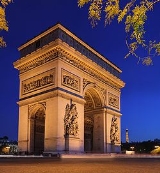
Arc de Triomphe
Overview
Astylar
Astylar is an architectural term given to a class of design in which neither columns nor pilasters are used for decorative purposes; thus the Riccardi and Strozzi palaces in Florence are astylar in their design, in contradistinction to Palladio's palaces at Vicenza, which are columnar....
design is by Jean Chalgrin
Jean Chalgrin
Jean-François-Thérèse Chalgrin was a French architect, best known for his design for the Arc de Triomphe, Paris.-Biography:...
(1739–1811), in the Neoclassical
Neoclassicism
Neoclassicism is the name given to Western movements in the decorative and visual arts, literature, theatre, music, and architecture that draw inspiration from the "classical" art and culture of Ancient Greece or Ancient Rome...
version of ancient Roman architecture
Roman architecture
Ancient Roman architecture adopted certain aspects of Ancient Greek architecture, creating a new architectural style. The Romans were indebted to their Etruscan neighbors and forefathers who supplied them with a wealth of knowledge essential for future architectural solutions, such as hydraulics...
(see, for example, the triumphal Arch of Titus
Arch of Titus
The Arch of Titus is a 1st-century honorific arch located on the Via Sacra, Rome, just to the south-east of the Roman Forum. It was constructed in c.82 AD by the Roman Emperor Domitian shortly after the death of his older brother Titus to commemorate Titus' victories, including the Siege of...
). Major academic
Academy
An academy is an institution of higher learning, research, or honorary membership.The name traces back to Plato's school of philosophy, founded approximately 385 BC at Akademia, a sanctuary of Athena, the goddess of wisdom and skill, north of Athens, Greece. In the western world academia is the...
sculptors of France are represented in the sculpture of the Arc de Triomphe: Jean-Pierre Cortot
Jean-Pierre Cortot
Jean-Pierre Cortot was a French sculptor.- Life :Cortot was born and died in Paris. He was educated at the Ecole des Beaux Arts in Paris, and took the Prix de Rome in 1809, residing in the Villa Medici in Rome from 1810 to 1813.Cortot worked in an austere, correct, academic neo-classical style,...
; François Rude
François Rude
François Rude was a French sculptor. He was the stepfather of Paul Cabet, a sculptor.Born in Dijon, he worked at his father's trade as a stovemaker till the age of sixteen, but received training in drawing from François Devosges, where he learned that a strong, simple contour was an invaluable...
; Antoine Étex
Antoine Étex
Antoine Étex was a French sculptor, painter and architect. He was born in Paris.He first exhibited in the Paris Salon of 1833, his work including a reproduction in marble of his "Death of Hyacinthus", and the plaster cast of his "Cain and his race cursed by God"...
; James Pradier
James Pradier
James Pradier, also known as Jean-Jacques Pradier was a Swiss-born French sculptor best known for his work in the neoclassical style.-Life and work:...
and Philippe Joseph Henri Lemaire
Philippe Joseph Henri Lemaire
[Philippe Joseph] Henri Lemaire was a French sculptor, working in a neoclassical academic style. He was a pupil of Pierre Cartellier, and won the Prix de Rome for sculpture in 1821....
. The main sculptures are not integral frieze
Frieze
thumb|267px|Frieze of the [[Tower of the Winds]], AthensIn architecture the frieze is the wide central section part of an entablature and may be plain in the Ionic or Doric order, or decorated with bas-reliefs. Even when neither columns nor pilasters are expressed, on an astylar wall it lies upon...
s but are treated as independent trophies applied to the vast ashlar
Ashlar
Ashlar is prepared stone work of any type of stone. Masonry using such stones laid in parallel courses is known as ashlar masonry, whereas masonry using irregularly shaped stones is known as rubble masonry. Ashlar blocks are rectangular cuboid blocks that are masonry sculpted to have square edges...
masonry masses, not unlike the gilt-bronze appliqué
Applique
In its broadest sense, an appliqué is a smaller ornament or device applied to another surface. In the context of ceramics, for example, an appliqué is a separate piece of clay added to the primary work, generally for the purpose of decoration...
s on Empire furniture
Empire (style)
The Empire style, , sometimes considered the second phase of Neoclassicism, is an early-19th-century design movement in architecture, furniture, other decorative arts, and the visual arts followed in Europe and America until around 1830, although in the U. S. it continued in popularity in...
. The four sculptural groups at the base of the Arc are The Triumph of 1810 (Cortot), Resistance and Peace (both by Antoine Étex) and the most renowned of them all, Departure of the Volunteers of 1792 commonly called La Marseillaise
La Marseillaise
"La Marseillaise" is the national anthem of France. The song, originally titled "Chant de guerre pour l'Armée du Rhin" was written and composed by Claude Joseph Rouget de Lisle in 1792. The French National Convention adopted it as the Republic's anthem in 1795...
(François Rude).
Unanswered Questions

